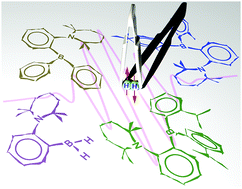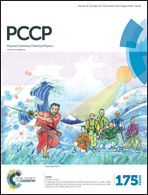Nuclear spin hyperpolarization with ansa-aminoboranes: a metal-free perspective for parahydrogen-induced polarization†
Abstract
The parahydrogen-induced polarization (PHIP) phenomenon, observed when parahydrogen is used in H2 addition processes, provides a means for substantial NMR signal enhancements and mechanistic studies of chemical reactions. Commonly, noble metal complexes are used for parahydrogen activation, whereas metal-free activation is rare. Herein, we report a series of unimolecular metal-free frustrated Lewis pairs based on an ansa-aminoborane (AAB) moiety in the context of PHIP. These molecules, which have a “molecular tweezers” structure, differ in their substituents at the boryl site (–H, –Ph, –o-iPr-Ph, and –Mes). PHIP effects were observed for all the AABs after exposing their solutions to parahydrogen in a wide temperature range, and experimental measurements of their kinetic and thermodynamic parameters were performed. A theoretical analysis of their nuclear spin polarization effects is presented, and the roles of chemical exchange, chemical equilibrium and spin dynamics are discussed in terms of the key dimensionless parameters. The analysis allowed us to formulate the prerequisites for achieving strong polarization effects with AAB molecules, which can be applied for further design of efficient metal-free tweezers-like molecules for PHIP. Mechanistic (chemical and physical) aspects of the observed effects are discussed in detail. In addition, we performed quantum chemical calculations, which confirmed that the J-coupling between the parahydrogen-originated protons in AAB–H2 molecules is mediated through dihydrogen bonding.


 Please wait while we load your content...
Please wait while we load your content...